Effects of Ionic Liquid, 1-Ethyl-3-methylimidazolium Chloride ([EMIM]Cl), on the Material and Electrical Characteristics of Asphaltene Thin Films
Abstract
:1. Introduction
2. Materials and Methods
2.1. Asphaltene Extraction
2.2. Preparation of Asphaltene and [EMIM]Cl Stock Solution
2.3. Thin-Film Formation
2.4. Elemental Analysis
2.5. Thin-Film Surface Analysis
2.6. Functional Groups Analysis Using ATR-FTIR
2.7. Sheet Resistance Measurement of the Asphaltene Thin Films
2.8. Optical Bandgap Determination from UV-Vis Spectroscopy
2.9. Fabrication of Organic Field-Effect Transistor (OFET)
2.10. Characterization of the OFET
3. Results and Discussion
3.1. Asphaltene Physical Appearance and Elemental Analysis
3.2. Thin-Film Surface Analysis
3.3. Functional Groups Analysis Using Attenuated Total Reflection Fourier Transform Infrared Spectroscopy (ATR-FTIR)
3.4. Sheet Resistance (RS) Measurement of the Asphaltene Thin Films
3.5. Optical Bandgap Determination from UV-Vis Spectroscopy
3.6. Characteristics of the Asphaltene-Based Organic Field-Effect Transistor (OFET)
4. Conclusions
Author Contributions
Funding
Institutional Review Board Statement
Informed Consent Statement
Data Availability Statement
Acknowledgments
Conflicts of Interest
References
- Chen, L.; Bertolini, A.; Dubost, F.; Achourov, V.; Betancourt, S.; Cañas, J.A.; Dumont, H.; Pomerantz, A.E.; Mullins, O.C. Yen–Mullins Model Applies to Oilfield Reservoirs. Energy Fuels 2020, 34, 14074–14093. [Google Scholar] [CrossRef]
- da Costa, L.M.; Stoyanov, S.R.; Gusarov, S.; Tan, X.; Gray, M.R.; Stryker, J.M.; Tykwinski, R.; de, M. Carneiro, J.W.; Seidl, P.R.; Kovalenko, A. Density Functional Theory Investigation of the Contributions of π–π Stacking and Hydrogen-Bonding Interactions to the Aggregation of Model Asphaltene Compounds. Energy Fuels 2012, 26, 2727–2735. [Google Scholar] [CrossRef]
- Zhao, R.; Zhang, R.-Q. A New Insight into π–π Stacking Involving Remarkable Orbital Interactions. Phys. Chem. Chem. Phys. 2016, 18, 25452–25457. [Google Scholar] [CrossRef] [PubMed]
- Anisimov, M.A.; Yudin, I.K.; Nikitin, V.; Nikolaenko, G.; Chernoutsan, A.; Toulhoat, H.; Frot, D.; Briolant, Y. Asphaltene Aggregation in Hydrocarbon Solutions Studied by Photon Correlation Spectroscopy. J. Phys. Chem. 1995, 99, 9576–9580. [Google Scholar] [CrossRef]
- Wang, H.; Xu, H.; Jia, W.; Liu, J.; Ren, S. Revealing the Intermolecular Interactions of Asphaltene Dimers by Quantum Chemical Calculations. Energy Fuels 2017, 31, 2488–2495. [Google Scholar] [CrossRef]
- Johnson, O.A.; Affam, A.C. Petroleum Sludge Treatment and Disposal: A Review. Environ. Eng. Res. 2018, 24, 191–201. [Google Scholar] [CrossRef]
- Ruiz-Morales, Y. HOMO−LUMO Gap as an Index of Molecular Size and Structure for Polycyclic Aromatic Hydrocarbons (PAHs) and Asphaltenes: A Theoretical Study. I. J. Phys. Chem. A 2002, 106, 11283–11308. [Google Scholar] [CrossRef]
- Neupane, G.P.; Ma, W.; Yildirim, T.; Tang, Y.; Zhang, L.; Lu, Y. 2D Organic Semiconductors, the Future of Green Nanotechnology. Nano Mater. Sci. 2019, 1, 246–259. [Google Scholar] [CrossRef]
- Kim, C.-H.; Kymissis, I. Graphene–Organic Hybrid Electronics. J. Mater. Chem. C 2017, 5, 4598–4613. [Google Scholar] [CrossRef]
- Ganeeva, Y.M.; Barskaya, E.E.; Okhotnikova, E.S.; Yusupova, T.N. Features of the Composition of Compounds Trapped in Asphaltenes of Oils and Bitumens of the Bavly Oil Field. Energy Fuels 2021, 35, 2493–2505. [Google Scholar] [CrossRef]
- Vekariya, R.L. A Review of Ionic Liquids: Applications towards Catalytic Organic Transformations. J. Mol. Liq. 2017, 227, 44–60. [Google Scholar] [CrossRef]
- Lei, Z.; Chen, B.; Koo, Y.-M.; MacFarlane, D.R. Introduction: Ionic Liquids. Chem. Rev. 2017, 117, 6633–6635. [Google Scholar] [CrossRef] [PubMed] [Green Version]
- Ghanem, A.; Alharthy, R.D.; Desouky, S.M.; El-Nagar, R.A. Synthesis and Characterization of Imidazolium-Based Ionic Liquids and Evaluating Their Performance as Asphaltene Dispersants. Materials 2022, 15, 1600. [Google Scholar] [CrossRef]
- Atabaki, F.; Yousefi, M.H.; Abdolmaleki, A.; Kalvandi, M. Poly(3,4-Ethylenedioxythiophene):Poly(Styrenesulfonic Acid) (PEDOT:PSS) Conductivity Enhancement through Addition of Imidazolium-Ionic Liquid Derivatives. Polym. Plast. Technol. Eng. 2015, 54, 1009–1016. [Google Scholar] [CrossRef]
- Berton, N.; Ottone, C.; Labet, V.; de Bettignies, R.; Bailly, S.; Grand, A.; Morell, C.; Sadki, S.; Chandezon, F. New Alternating Copolymers of 3,6-Carbazoles and Dithienylbenzothiadiazoles: Synthesis, Characterization, and Application in Photovoltaics: Macromol. Chem. Phys. 2011, 212, 2127–2141. [Google Scholar] [CrossRef]
- Amin, P.O.; Ketuly, K.A.; Saeed, S.R.; Muhammadsharif, F.F.; Symes, M.D.; Paul, A.; Sulaiman, K. Synthesis, Spectroscopic, Electrochemical and Photophysical Properties of High Band Gap Polymers for Potential Applications in Semi-Transparent Solar Cells. BMC Chem. 2021, 15, 25. [Google Scholar] [CrossRef]
- IEEE. IEEE Standard for Test Methods for the Characterization of Organic Transistors and Materials; IEEE: Piscataway, NJ, USA, 2008. [Google Scholar] [CrossRef]
- Goetz, K.P.; Jurchescu, O.D. Conductivity Measurements of Organic Materials Using Field-Effect Transistors (FETs) and Space-Charge-Limited Current (SCLC) Techniques. In Handbook of Organic Materials for Electronic and Photonic Devices; Elsevier: Amsterdam, The Netherlands, 2019; pp. 453–487. [Google Scholar] [CrossRef]
- Kus, M.; Alic, T.Y.; Kirbiyik, C.; Baslak, C.; Kara, K.; Kara, D.A. Synthesis of Nanoparticles. In Handbook of Nanomaterials for Industrial Applications; Elsevier: Amsterdam, The Netherlands, 2018; pp. 392–429. [Google Scholar] [CrossRef]
- Guerrero-Ruiz, A.; Rodriguez-Ramos, I.; Rodriguez-Reinoso, F.; Moreno-Castilla, C.; López-González, J.D. The Role of Nitrogen and Oxygen Surface Groups in the Behavior of Carbon-Supported Iron and Ruthenium Catalysts. Carbon 1988, 26, 417–423. [Google Scholar] [CrossRef]
- Kiciński, W.; Szala, M.; Bystrzejewski, M. Sulfur-Doped Porous Carbons: Synthesis and Applications. Carbon 2014, 68, 1–32. [Google Scholar] [CrossRef]
- Anuar, N.; Subban, R.; Mohamed, N. Properties of PEMA-NH4CF3SO3 Added to BMATSFI Ionic Liquid. Materials 2012, 5, 2609–2620. [Google Scholar] [CrossRef]
- Singh, P.K.; Kim, K.-W.; Nagarale, R.K.; Rhee, H.-W. Preparation, Characterization and Application of Ionic Liquid Doped Solid Polymer Electrolyte Membranes. J. Phys. D Appl. Phys. 2009, 42, 125101. [Google Scholar] [CrossRef]
- Bazaka, K.; Jacob, M.; Truong, V.K.; Crawford, R.J.; Ivanova, E.P. The Effect of Polyterpenol Thin Film Surfaces on Bacterial Viability and Adhesion. Polymers 2011, 3, 388–404. [Google Scholar] [CrossRef] [Green Version]
- Aqil, M.M.; Azam, M.A.; Aziz, M.F.; Latif, R. Deposition and Characterization of Molybdenum Thin Film Using Direct Current Magnetron and Atomic Force Microscopy. J. Nanotechnol. 2017, 2017, 4862087. [Google Scholar] [CrossRef] [Green Version]
- Babicka, M.; Woźniak, M.; Dwiecki, K.; Borysiak, S.; Ratajczak, I. Preparation of Nanocellulose Using Ionic Liquids: 1-Propyl-3-Methylimidazolium Chloride and 1-Ethyl-3-Methylimidazolium Chloride. Molecules 2020, 25, 1544. [Google Scholar] [CrossRef] [PubMed] [Green Version]
- Lee, D.U.; Jeong, J.Y.; Han, J.W.; Kwon, G.-C.; Attri, P.; Kim, I.T. Effect of Ionic Liquids on the Physical Properties of the Newly Synthesized Conducting Polymer. Int. J. Polym. Sci. 2018, 2018, 8275985. [Google Scholar] [CrossRef] [Green Version]
- Talari, A.C.S.; Martinez, M.A.G.; Movasaghi, Z.; Rehman, S.; Rehman, I.U. Advances in Fourier Transform Infrared (FTIR) Spectroscopy of Biological Tissues. Appl. Spectrosc. Rev. 2017, 52, 456–506. [Google Scholar] [CrossRef]
- Abdul Ghani, N.A.; Anuar, F.H.; Ahmad, A.; Mobarak, N.N.; Shamsudin, I.J.; Dzulkipli, M.Z.; Hassan, N.H. Incorporating 1-Butyl-3-Methylimidazolium Chloride Ionic Liquid into Iota Carrageenan Solid Biopolymer Electrolyte for Electrochemical Devices Application. Sains Malays. 2020, 49, 305–313. [Google Scholar] [CrossRef]
- Thulasiraman, S.; Yunus, N.M.M.; Kumar, P.; Burhanudin, Z.A.; Wilfred, C.D.; Ariffin, A.; Hamdan, M.F.; Hamid, N.H. Characteristics of Asphaltenes Thin Film Extracted from Crude-Oil-Tank-Bottom-Sludge (COTBS). In Proceedings of the 2019 IEEE Regional Symposium on Micro and Nanoelectronics (RSM), Putrajaya, Malaysia, 21–23 August 2019; pp. 42–45. [Google Scholar] [CrossRef]
- Dhapola, P.S.; Singh, P.K.; Bhattacharya, B.; Surana, K.; Mehra, R.; Gupta, M.; Singh, A.; Singh, V.; Sahoo, N.G. Electrical, Thermal, and Dielectric Studies of Ionic Liquid-Based Polymer Electrolyte for Photoelectrochemical Device. High. Perform. Polym. 2018, 30, 1002–1008. [Google Scholar] [CrossRef]
- Singh, P.K.; Bhattacharya, B.; Nagarale, R.K.; Kim, K.-W.; Rhee, H.-W. Synthesis, Characterization and Application of Biopolymer-Ionic Liquid Composite Membranes. Synth. Met. 2010, 160, 139–142. [Google Scholar] [CrossRef]
- Döbbelin, M.; Marcilla, R.; Salsamendi, M.; Pozo-Gonzalo, C.; Carrasco, P.M.; Pomposo, J.A.; Mecerreyes, D. Influence of Ionic Liquids on the Electrical Conductivity and Morphology of PEDOT:PSS Films. Chem. Mater. 2007, 19, 2147–2149. [Google Scholar] [CrossRef]
- Wu, X.; Surendran, A.; Ko, J.; Filonik, O.; Herzig, E.M.; Müller-Buschbaum, P.; Leong, W.L. Ionic-Liquid Doping Enables High Transconductance, Fast Response Time, and High Ion Sensitivity in Organic Electrochemical Transistors. Adv. Mater. 2019, 31, 1805544. [Google Scholar] [CrossRef] [PubMed]
- Nikafshar, S.; Zabihi, O.; Ahmadi, M.; Mirmohseni, A.; Taseidifar, M.; Naebe, M. The Effects of UV Light on the Chemical and Mechanical Properties of a Transparent Epoxy-Diamine System in the Presence of an Organic UV Absorber. Materials 2017, 10, 180. [Google Scholar] [CrossRef] [PubMed]
- Chen, F.; Wang, Y.; Xie, X.; Chen, M.; Li, W. TDDFT Study of UV–Vis Spectra of Permethrin, Cypermethrin and Their Beta-Cyclodextrin Inclusion Complexes: A Comparison of Dispersion Correction DFT (DFT-D3) and DFT. Spectrochim. Acta Part A Mol. Biomol. Spectrosc. 2014, 128, 461–467. [Google Scholar] [CrossRef] [PubMed]
- Yokota, T.; Scriven, F.; Montgomery, D.S.; Strausz, O.P. Absorption and Emission Spectra of Athabasca Asphaltene in the Visible and near Ultraviolet Regions. Fuel 1986, 65, 1142–1149. [Google Scholar] [CrossRef]
- Breda, S.; Reva, I.D.; Lapinski, L.; Nowak, M.J.; Fausto, R. Infrared Spectra of Pyrazine, Pyrimidine and Pyridazine in Solid Argon. J. Mol. Struct. 2006, 786, 193–206. [Google Scholar] [CrossRef] [Green Version]
- Silverstein, R.M.; Bassler, G.C. Spectrometric Identification of Organic Compounds. J. Chem. Educ. 1962, 39, 546–553. [Google Scholar] [CrossRef]
- Ferralis, N.; Liu, Y.; Bake, K.D.; Pomerantz, A.E.; Grossman, J.C. Direct Correlation between Aromatization of Carbon-Rich Organic Matter and Its Visible Electronic Absorption Edge. Carbon 2015, 88, 139–147. [Google Scholar] [CrossRef]
- Singh, M.; Goyal, M.; Devlal, K. Size and Shape Effects on the Band Gap of Semiconductor Compound Nanomaterials. J. Taibah Univ. Sci. 2017, 12, 470–475. [Google Scholar] [CrossRef] [Green Version]
- Beriso, A. Determination of Size-Dependent Energy Bandgap of Germanium (Ge) Nanostructure. Adv. Phys. Theor. Appl. 2019, 77, 1–5. [Google Scholar] [CrossRef]
- Lombardo, S.; Stathis, J.H.; Linder, B.P.; Pey, K.L.; Palumbo, F.; Tung, C.H. Dielectric Breakdown Mechanisms in Gate Oxides. J. Appl. Phys 2005, 98, 121301. [Google Scholar] [CrossRef]
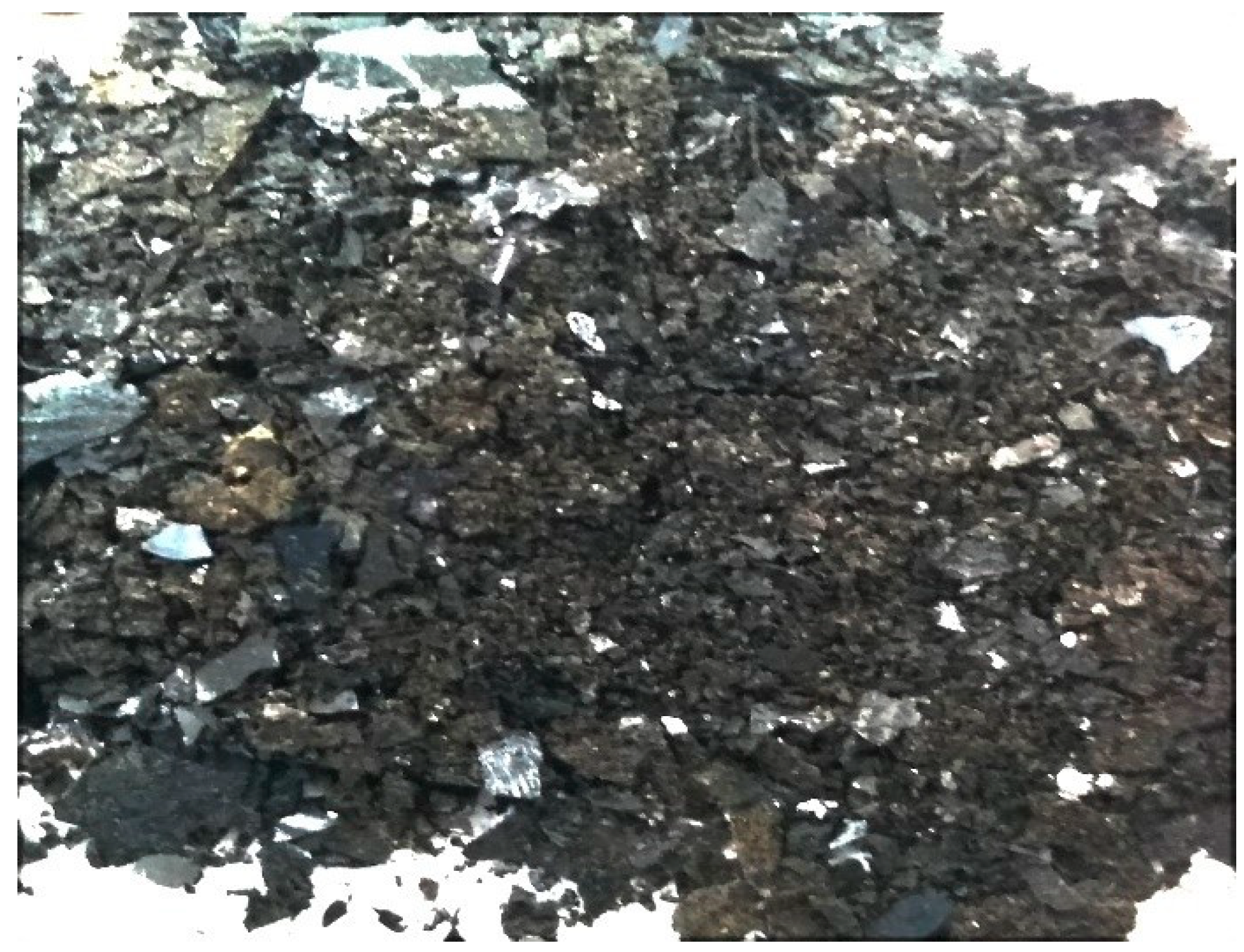
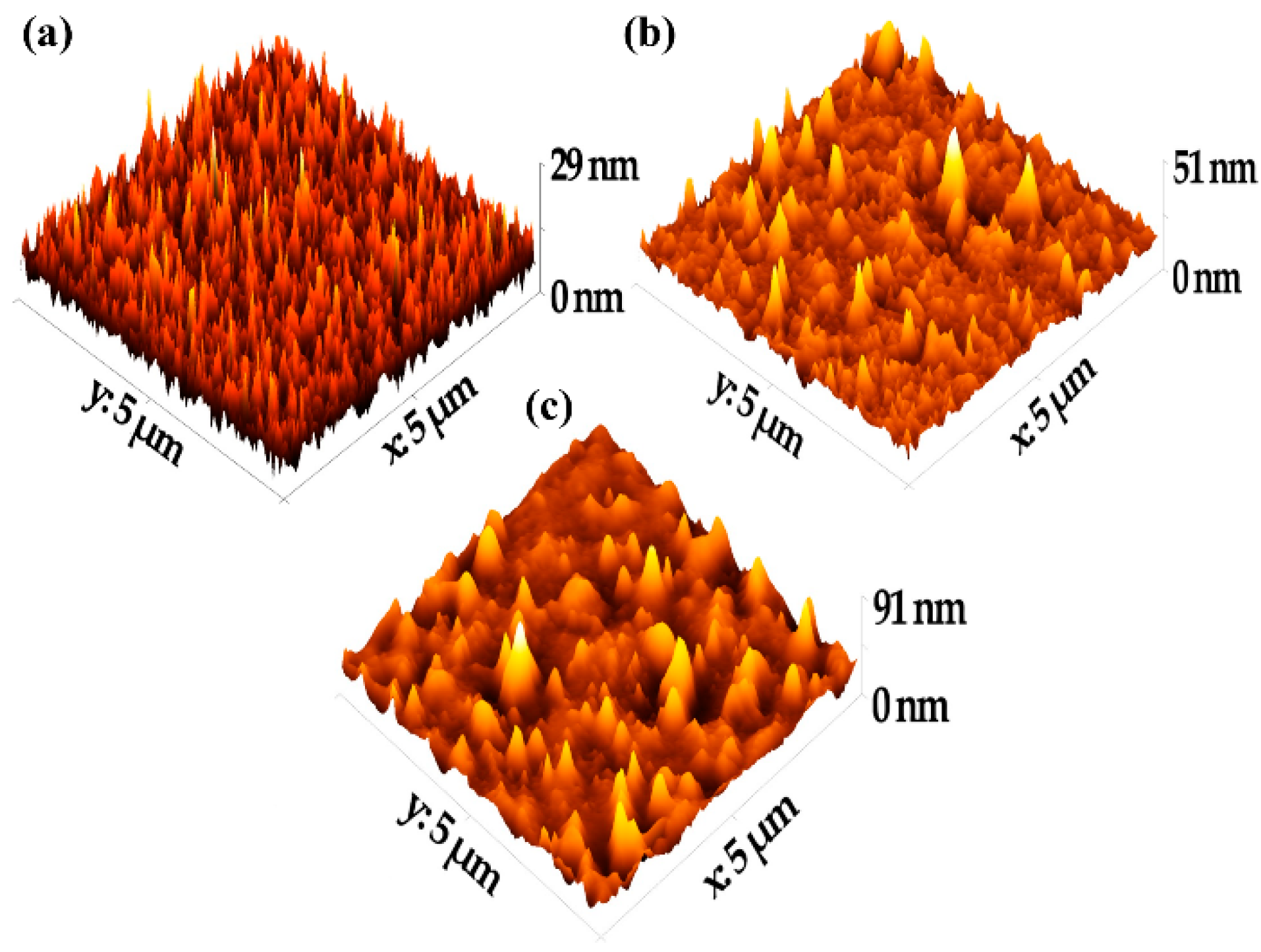
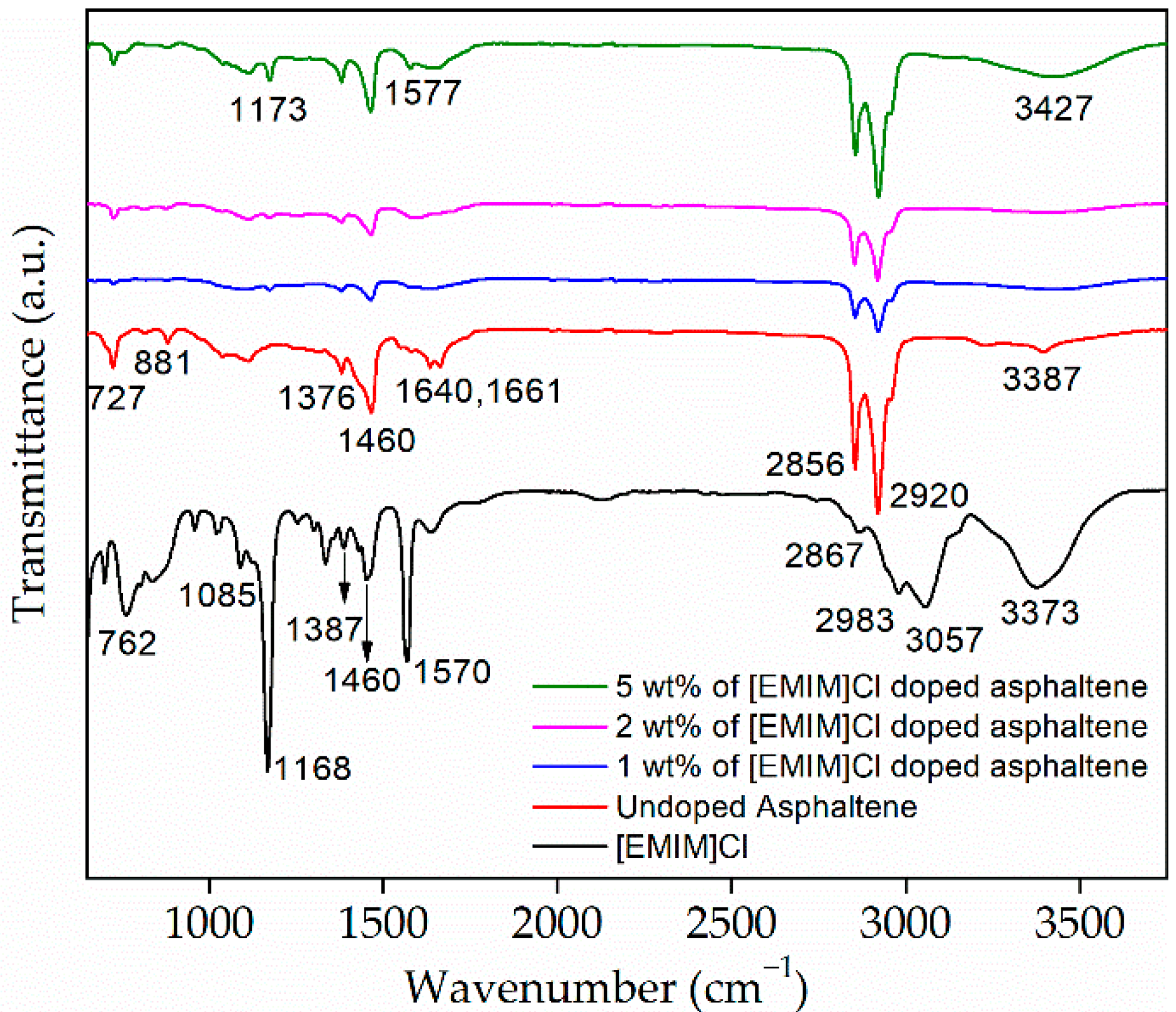
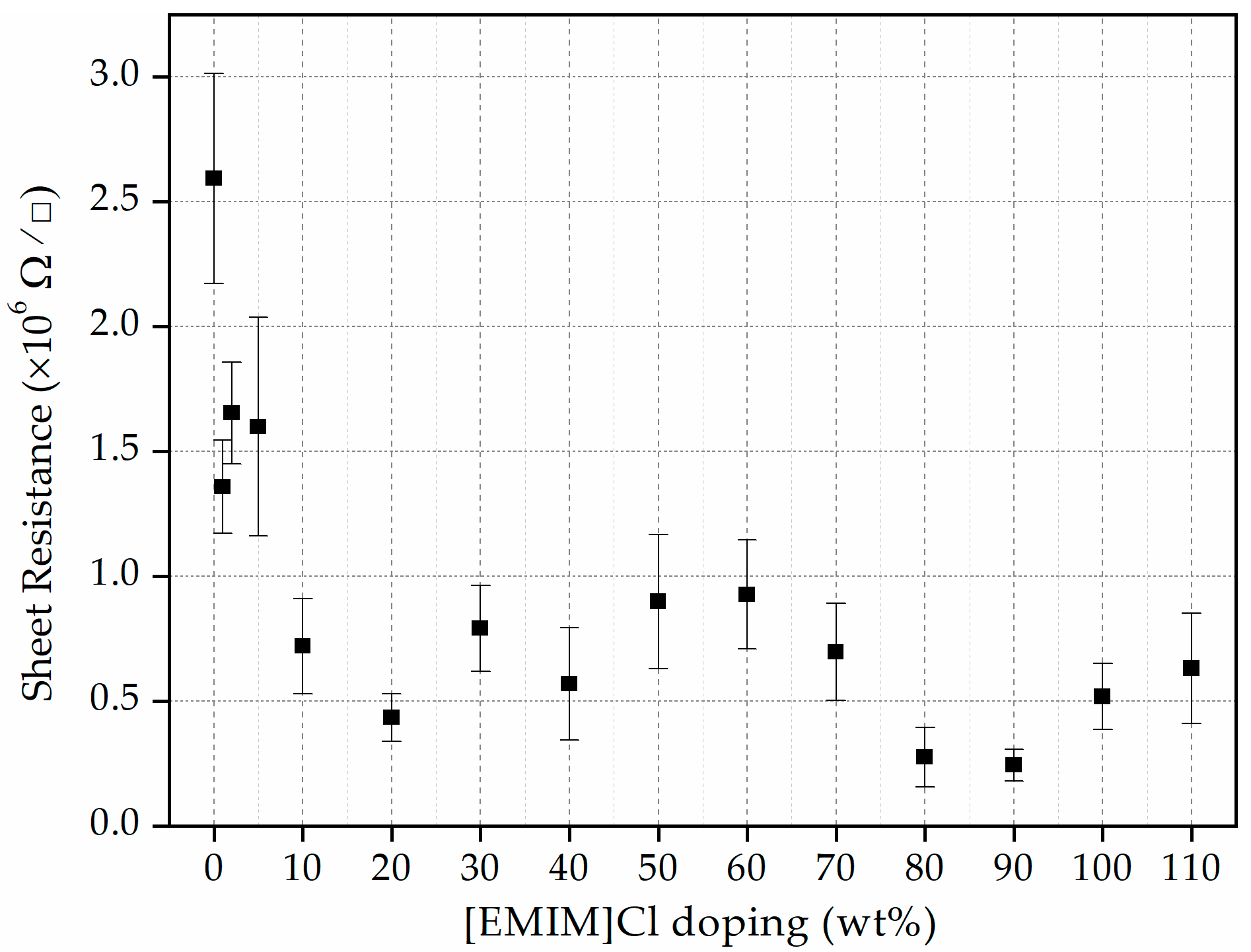

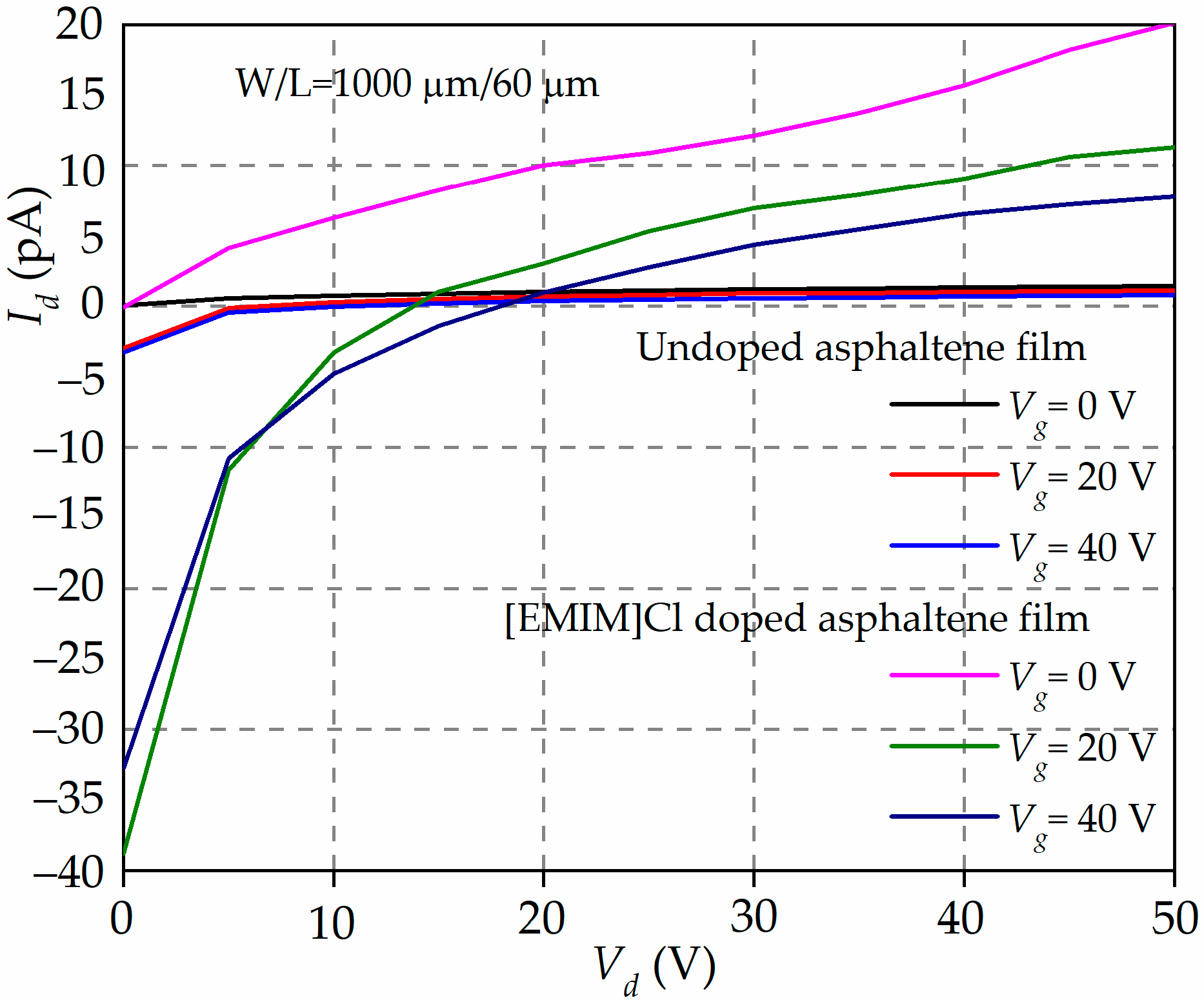
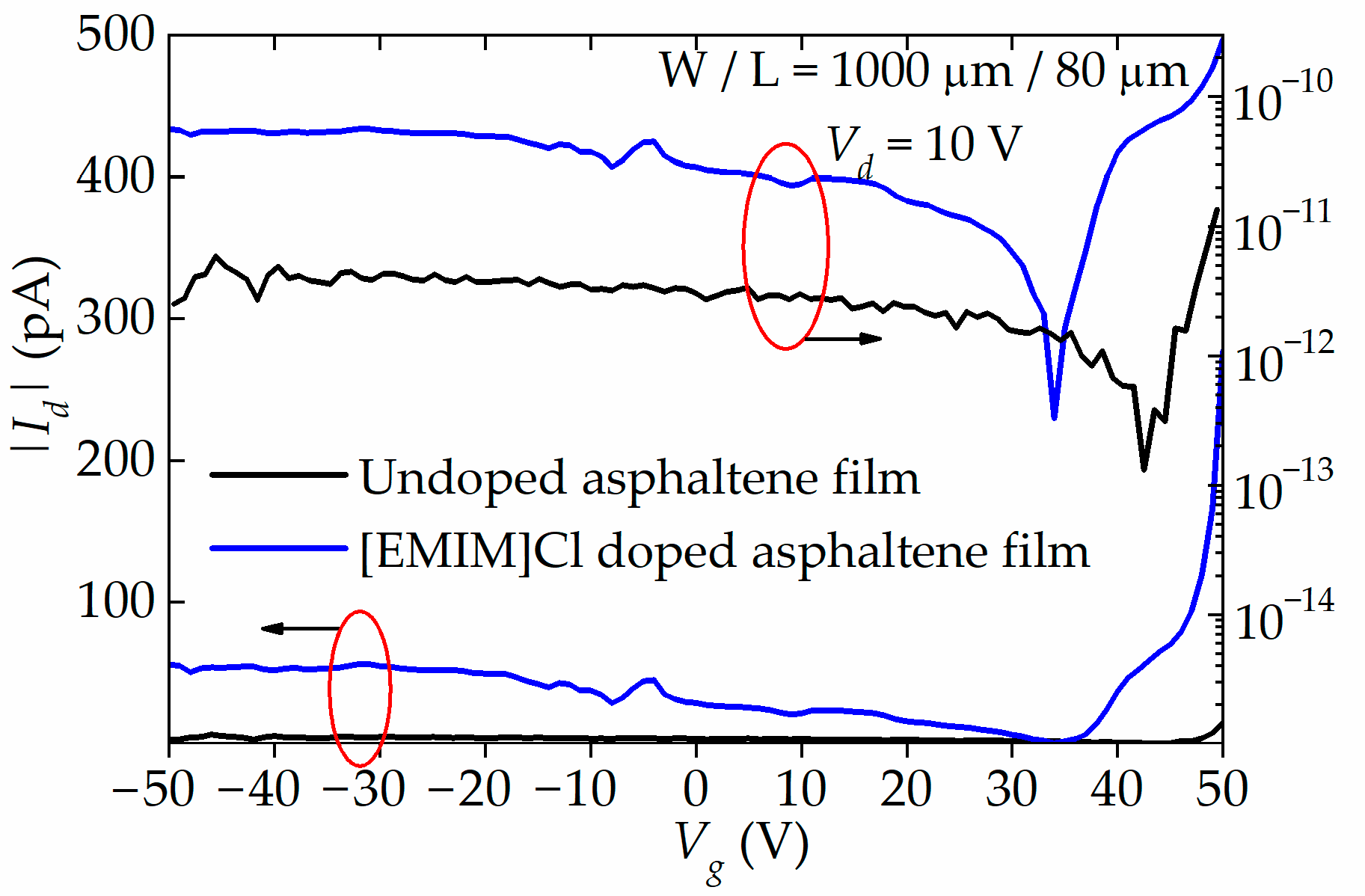
| Elements | Thermally Treated COTBS (wt%) | Untreated COTBS (wt%) |
|---|---|---|
| C | 81.76 | 64.22 |
| H | 8.91 | 9.83 |
| N | 1.31 | 0.59 |
| S | 1.43 | 0.68 |
| Samples | RMS (nm) | Sa (nm) | Skew (Ssk) | Excess Kurtosis |
|---|---|---|---|---|
| Glass | 3.37 | 2.65 | 0.64 | 0.72 |
| Asphaltene on glass | 7.92 | 5.27 | 1.26 | 3.82 |
| 90 wt% [EMIM]Cl-doped asphaltene on glass | 3.76 | 2.59 | 1.67 | 7.68 |
| Wavenumber (cm−1) | Description |
|---|---|
| 724 | four adjacent aromatic C-H |
| 762 | C-H out-of-plane bending |
| 881 | Out-of-plane deformation vibration of one isolated aromatic C-H |
| 1085 | C-N stretching |
| 1168 | C-C stretching |
| 1173 | C-OH non-hydrogen bonded stretching |
| 1376, 1460 | Methyl C-H symmetric/asymmetric bending |
| 1661–1640 | C=O (carbonyl) stretching |
| 2856, 2920 | Methylene C-H symmetric/asymmetric stretching |
| 2867, 2983 | Methyl C-H symmetric/asymmetric stretching |
| 3057 | N-H stretching of amide |
| 3373, 3427 | O-H stretching |
| Asphaltene Film | λmax (nm) | λonset (nm) | Optical Band Gap (eV) |
|---|---|---|---|
| Undoped | 265 | 331 | 3.74 |
| 1 wt% of [EMIM]Cl | 260 | 328 | 3.78 |
| 2 wt% of [EMIM]Cl | 275 | 324 | 3.82 |
| 5 wt% of [EMIM]Cl | 275 | 322 | 3.85 |
| Channel Length (µm) | Undoped Asphaltene OFET | [EMIM]Cl-Doped Asphaltene OFET | ||||||
|---|---|---|---|---|---|---|---|---|
| µh (cm2/Vs) | µe (cm2/Vs) | Vth (V) | SS (V/dec) | µh (cm2/Vs) | µe (cm2/Vs) | Vth (V) | SS (V/dec) | |
| 30 | 6.28 × 10−8 | 6.53 × 10−7 | 43.2 | 3.956 | 5.52 × 10−8 | 1.69 × 10−6 | 37.2 | 3.586 |
| 40 | 5.99 × 10−8 | 6.04 × 10−7 | 43.3 | 3.258 | 5.05 × 10−8 | 1.14 × 10−6 | 33.1 | 2.687 |
| 50 | 5.54 × 10−8 | 5.27 × 10−7 | 42.9 | 3.536 | 8.64 × 10−8 | 1.07 × 10−6 | 42.1 | 1.471 |
| 60 | 3.81 × 10−8 | 23.1 × 10−7 | 42.5 | 3.569 | 11.0 × 10−8 | 0.31 × 10−6 | 33.8 | 2.415 |
| 80 | 2.83 × 10−8 | 7.65 × 10−7 | 42.9 | 3.577 | 15.4 × 10−8 | 1.02 × 10−6 | 34.0 | 3.072 |
Publisher’s Note: MDPI stays neutral with regard to jurisdictional claims in published maps and institutional affiliations. |
© 2022 by the authors. Licensee MDPI, Basel, Switzerland. This article is an open access article distributed under the terms and conditions of the Creative Commons Attribution (CC BY) license (https://creativecommons.org/licenses/by/4.0/).
Share and Cite
Thulasiraman, S.; Yunus, N.M.M.; Kumar, P.; Kesuma, Z.R.; Norhakim, N.; Wilfred, C.D.; Roffi, T.M.; Hamdan, M.F.; Burhanudin, Z.A. Effects of Ionic Liquid, 1-Ethyl-3-methylimidazolium Chloride ([EMIM]Cl), on the Material and Electrical Characteristics of Asphaltene Thin Films. Materials 2022, 15, 2818. https://doi.org/10.3390/ma15082818
Thulasiraman S, Yunus NMM, Kumar P, Kesuma ZR, Norhakim N, Wilfred CD, Roffi TM, Hamdan MF, Burhanudin ZA. Effects of Ionic Liquid, 1-Ethyl-3-methylimidazolium Chloride ([EMIM]Cl), on the Material and Electrical Characteristics of Asphaltene Thin Films. Materials. 2022; 15(8):2818. https://doi.org/10.3390/ma15082818
Chicago/Turabian StyleThulasiraman, Sundarajoo, Noor Mona Md Yunus, Pradeep Kumar, Zayyan Rafi Kesuma, Nadia Norhakim, Cecilia Devi Wilfred, Teuku Muhammad Roffi, Mohamad Faizal Hamdan, and Zainal Arif Burhanudin. 2022. "Effects of Ionic Liquid, 1-Ethyl-3-methylimidazolium Chloride ([EMIM]Cl), on the Material and Electrical Characteristics of Asphaltene Thin Films" Materials 15, no. 8: 2818. https://doi.org/10.3390/ma15082818
APA StyleThulasiraman, S., Yunus, N. M. M., Kumar, P., Kesuma, Z. R., Norhakim, N., Wilfred, C. D., Roffi, T. M., Hamdan, M. F., & Burhanudin, Z. A. (2022). Effects of Ionic Liquid, 1-Ethyl-3-methylimidazolium Chloride ([EMIM]Cl), on the Material and Electrical Characteristics of Asphaltene Thin Films. Materials, 15(8), 2818. https://doi.org/10.3390/ma15082818







